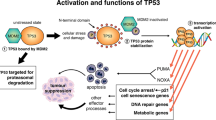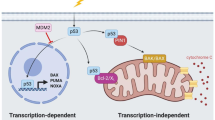Abstract
Until recently, the ability of ARF (human p14ARF, murine p19ARF) tumour-suppressor protein, encoded by the INK4A/ARF locus, to inhibit cell growth in response to various stimuli was related to its ability to stabilize p53 through the so-called ARF/MDM2/p53 pathway. However, recent data have demonstrated that ARF is not implicated in this unique p53-dependent pathway. By use of transient and stable expression, we show here that human p14ARF inhibits the growth of human tumoral cells lacking functional p53 by inducing a transient G2 arrest and subsequently apoptosis. This p14ARF–induced G2 arrest was correlated with inhibition of CDC2 activity, inactivation of CDC25C phosphatase and induction of the CDK inhibitor p21WAFI. Apoptosis was demonstrated using Hoechst 33352 staining, proteolytic activation of caspase-3 and PARP cleavage. Similar results were obtained in experiments with cells synchronized by hydroxyurea block. Importantly, we were able to reproduce these effects ‘in vivo’ by showing that p14ARF inhibits the growth of p53 nullizygous human tumours in nude mice and induces the regression of p53 −/− established tumours. In these experiments, tumoral regression was associated with inhibition of cell proliferation as well as induction of apoptosis confirming the data obtained in cell lines.
This is a preview of subscription content, access via your institution
Access options
Subscribe to this journal
Receive 50 print issues and online access
$259.00 per year
only $5.18 per issue
Buy this article
- Purchase on Springer Link
- Instant access to full article PDF
Prices may be subject to local taxes which are calculated during checkout







Similar content being viewed by others
Change history
19 April 2021
A Correction to this paper has been published: https://doi.org/10.1038/s41388-021-01648-1
References
Agarwal ML, Agarwal A, Taylor WR, and Stark GR . (1995). Proc. Natl. Acad. Sci. USA, 92, 8493–8497.
Athar M, Kim AL, Ahmad N, Mukhtar H, Gautier J and Bickers DR . (2000). Biochem. Biophys. Res. Commun., 277, 107–111.
Bates S, Phillips AC, Clark PA, Stott F, Peters G, Ludwig RL and Vousden KH . (1998). Nature, 395, 124–125.
Blasina A, Paegle ES and McGowan CH . (1997). Mol. Biol. Cell, 8, 1013–1023.
Bunz F, Dutriaux A, Lengauer C, Waldman T, Zhou S, Brown JP, Sedivy JM, Kinzler KW and Vogelstein B . (1998). Science, 282, 1497–1501.
Carnero A, Hudson JD, Price CM and Beach DH . (2000). Nat. Cell. Biol., 2, 148–155.
Chin L, Pomerantz J and DePinho RA . (1998). Trends Biochem. Sci., 23, 291–296.
Coleman TR and Dunphy WG . (1994). Curr. Opin. Cell Biol., 6, 877–882.
Cong F, Zou X, Hinrichs K, Calame K and Goff SP . (1999). Oncogene, 18, 7731–7739.
de Stanchina E, McCurrach ME, Zindy F, Shieh SY, Ferbeyre G, Samuelson AV, Prives C, Roussel MF, Sherr CJ and Lowe SW . (1998). Genes Dev., 12, 2434–2442.
Dimri GP, Ithana K, Acosta M and Campisis J . (2000). Mol. Cell. Biol., 20, 273–285.
Draetta GF . (1997). Curr Biol., 7, R50–R52.
Dulic V, Stein GH, Far DF and Reed SI . (1998). Mol. Cell. Biol., 18, 546–557.
Elledge SJ . (1996). Science, 274, 1664–1672.
Esteller M, Tortola S, Toyata M, Capella G, Peinado MA, Baylin SB and Herman JG . (2000).Cancer Res., 60, 129–133.
Eymin B, Karayan L, Seite P, Brambilla C, Brambilla E, Larsen CJ and Gazzeri S . (2001). Oncogene, 10, 1033–1041.
Fan S, Smith ML, Rivet II DJ, Duba D, Zhan Q, Kohn KW, Fornace Jr AJ and O'Connor PM . (1995). Cancer Res., 55, 1649–1654.
Furnari B, Rhind N and Russell P . (1997). Science, 277, 1495–1497.
Gazzeri S, Della Valle V, Chaussade L, Beambilla C, Larsen CJ and Brambilla E . (1998). Cancer Res., 58, 3926–3931.
Goldstone S, Pavey S, Forrest A, Sinnamon J and Gabrielli B . (2001). Oncogene, 20, 921–932.
Graves PR, Yu L, Schwarz JK, Gales J, Sausville EA, O'Connor PM and Piwnica-Worms H . (2000). J. Biol. Chem., 275, 5600–5605.
Harper JW, Elledge SJ, Keyomarsi K, Dynlacht B, Tsai LH, Zhang P, Dobrowolski S, Bai C, Connell-Crowley L and Swindell E (1995). Mol. Biol. Cell., 6, 387–400.
Hartwell LH and Weinert TA . (1989). Science, 246, 629–634.
Hemmati PG, Gillissen B, von Haefen C, Wendt J, Starck L, Guner D, Dorken B and Daniel PT . (2002). Oncogene, 21, 3149–3161.
Kamijo T, Bodner S, van de Kamp E, Randle DH and Sherr CJ . (1999). Cancer Res., 59, 2217–2222.
Kamijo T, Zindy F, Roussel MF, Quelle DE, Downing JR, Ashmun RA, Grosveld G and Sherr CJ . (1997). Cell, 91, 649–659.
Kumagai A and Dunphy WG . (1991). Cell, 64, 903–914.
Labat-Moleur F, Guillermet C, Lorimier P, Robert C, Lantuejoul S, Brambilla E and Negoescu A . (1998). J. Histochem. Cytochem., 46, 327–334.
Li CY, Nagasawa H, Dahlberg WK and Little JB . (1995). Oncogene, 11, 1885–1892.
Li Y, Jenkins CW, Nichols MA and Xiong Y . (1994). Oncogene, 9, 2261–2268.
Lindstrom MS, Klangby U, Inoue R, Pisa P, Wiman KG and Asker CE . (2000). Exp. Cell Res., 256, 400–410.
Lowe SW, Schmitt EM, Smith SW, Osborne BA and Jacks T . (1993). Nature, 362, 847–849.
Mailand N, Falck J, Lukas C, Syljuasen RG, Welcker M, Bartek J and Lukas J . (2000). Science, 288, 1425–1429.
Millar JB, Blevitt J, Gerace L, Sadhu K, Featherstone C and Russell P . (1991). Proc. Natl. Acad. Sci. USA, 88, 10500–10504.
NiculescuIII AB, Chen X, Smeets M, Hentgst L, Prives C and Reed SI . (1998). Mol. Cell. Biol., 18, 629–643.
Norbury C, Blow J and Nurse P . (1991). Embo. J., 10, 3321–3329.
O'Connell MJ, Walworth NC, and Carr AM . (2000). Trends. Cell Biol., 10, 296–303.
Palmero I, Pantoja C and Serrano M . (1998). Nature, 395, 125–126.
Peng CY, Graves PR, Thoma RS, Wu Z, Shaw AS and Piwnica-Worms H . (1997). Science, 277, 1501–1505.
Poon RY, Chau MS, Yamashita K and Hunter T . (1997). Cancer Res., 57, 5168–5178.
Powel SN, DeFrank JS, Connel P, Eogan M, Preffer F, Dombkowski D, Tang W and Friend S . (1995). Cancer Res., 55, 1643–1648.
Quelle DE, Zindy F, Ashumun RA, and Sherr CJ . (1995). Cell., 83, 993–1000.
Radfar A, Unnikrishnan I, Lee HW, DePinho RA and Rosenberg N . (1998). Proc. Natl. Acad. Sci. USA, 95, 13194–13199.
Raj K, Ogston P and Beard P . (2001). Nature, 412, 914–917.
Rhind N, Furnari B and Russell P . (1997). Genes Dev., 11, 504–511.
Russo AA, Jeffrey PD and Pavletich NP . (1996). Nat. Struct. Biol., 3, 696–700.
Sanchez Y, Wong C, Thoma RS, Richman R, Wu Z, Piwnica-Worms H and Elledge SJ (1997). Science, 277, 1497–1501.
Sanchez-Cespedes M, Reed AL, Buta M, Wu L, Westra WH, Herman JG, Yang SC, Jen J and Sidransky D . (1999). Oncogene, 18, 5843–5849.
Serrano M, Hannon GJ and Beach D . (1993). Nature, 366, 704–770.
Serrano M, Lin AW, McCurrach, ME Beach D and Lowe SW . (1997). Cell, 88, 593–602.
Sherr CJ . (1998). Genes Dev. 12, 2984–2991.
Sherr CJ . (2001). Nat. Rev. Mol. Cell Biol. 2, 731–737.
Smits VA, Klompmaker R, Vallenius T, Rijksen G, Makele TP and Medema RH . (2000). J. Biol. Chem., 275, 30638–30643.
Stott FJ, Bates S, James MC, McConnell BB, Starborg M, Brookes S, Palmero I Ryan K, Hara E, Vousden KH, Peters G . (1998). Embo J. 17, 5001–5014.
Strausfeld U, Labbe JC, Fesquet D, Cavadore JC, Picard A, Sadhu K, Russell P and Doree M . (1991). Nature, 351, 242–245.
Takizawa CG and Morgen DO . (2000). Curr. Opin. Cell Biol., 12, 658–665.
Tao W and Levine AJ . (1999). Proc, Natl. Acad. Sci. USA, 96, 6937–6941.
Walworth NC . (2000). Curr. Opin. Cell Biol., 12, 697–704.
Wang X, McGowan CH, Zhao M, He L, Downey JS, Fearns C, Wang Y, Huang S and Han J . (2000). Mol. Cell Biol., 20, 4543–4552.
Weber HO, Samuel T, Rauch P and Funk JO . (2002). Oncogene, 21, 3207–3212.
Weber JD, Jeffers JR, Rehg JE, Randle DH, Lozano G, Roussel MF, Sherr CJ and Zambetti GP . (2000). Genes Dev. 14, 2358–2365.
Weber JD, Taylor LJ, Roussle MF and Bar-Sagi D . (1999). Nat. Cell Biol., 1,20–26.
Weinert T . (1997). Science, 277, 1450–1451.
Winters ZE, Ongkeko WM, Harris AL and Norbury CJ . (1998). Oncogene, 17, 673–684.
Yarbrough WG, Bessho M, Zanation A, Bisi JE and Xiong Y . (2002). Cancer Res., 62, 1171–1177.
Ye XS, Fincher RR, Tang A, O'Donnell K and Osmani SA . (1996). Embo. J., 15, 3599–3610.
Yu D, Jing T, Liu B, Yao J, Tan M, McDonnell TJ and Hung MC . (1998). Mol. Cell, 2, 581–591.
Zhang Y and Xiong Y . (1999). Mol. cell, 3, 579–591.
Zindy F, Eischen CM, Randle DH, Kamijo T, Cleveland JL, Sherr CJ and Roussel MF . (1998). Genes Dev., 12, 2424–2433.
Acknowledgements
This work was supported by a grant to EB from La Ligue Nationale Contre le Cancer as an ‘équipe Pabefliseeacute;’ and by the Association pour la Recherche le Cancer. BE was supported by INSERM; (Poste Accueil). We thank Christine Oddou, Pascal Perron, Christine Claraz and Sylvie Veyrenc for technical assistance.
Author information
Authors and Affiliations
Corresponding author
Rights and permissions
About this article
Cite this article
Eymin, B., Leduc, C., Coll, JL. et al. p14ARF induces G2 arrest and apoptosis independently of p53 leading to regression of tumours established in nude mice. Oncogene 22, 1822–1835 (2003). https://doi.org/10.1038/sj.onc.1206303
Received:
Revised:
Accepted:
Published:
Issue Date:
DOI: https://doi.org/10.1038/sj.onc.1206303
Keywords
This article is cited by
-
Roles of ARF tumour suppressor protein in lung cancer: time to hit the nail on the head!
Molecular and Cellular Biochemistry (2021)
-
CDKN2A, CDK1, and CCNE1 overexpression in sebaceous gland carcinoma of eyelid
International Ophthalmology (2020)
-
Overexpression of CCDC69 activates p14ARF/MDM2/p53 pathway and confers cisplatin sensitivity
Journal of Ovarian Research (2019)
-
Defined factors to reactivate cell cycle activity in adult mouse cardiomyocytes
Scientific Reports (2019)
-
VEGF165b, a splice variant of VEGF-A, promotes lung tumor progression and escape from anti-angiogenic therapies through a β1 integrin/VEGFR autocrine loop
Oncogene (2019)



